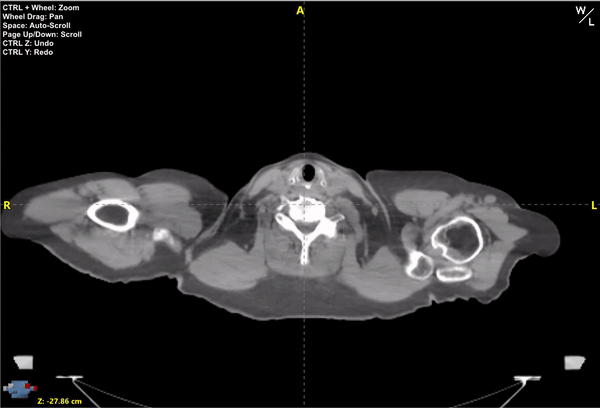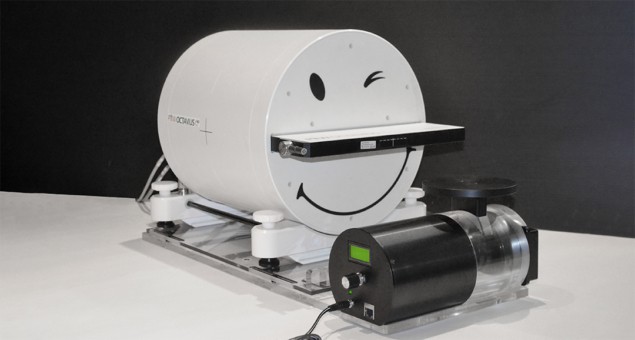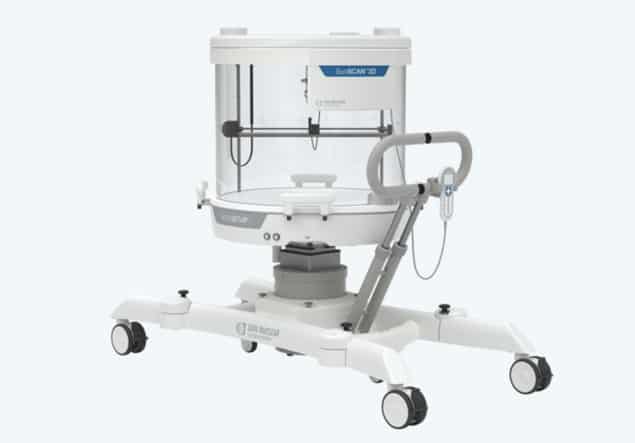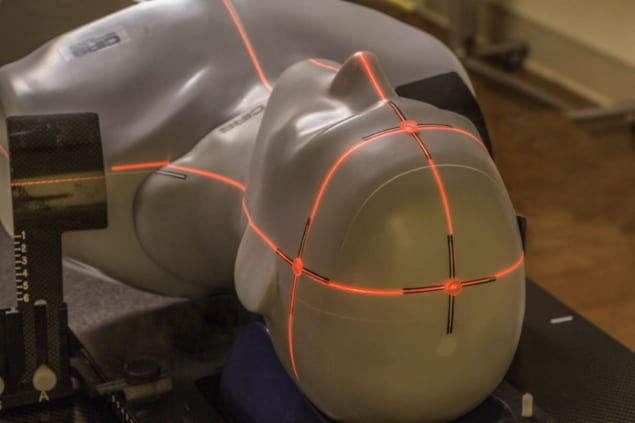The annual meeting of the European Society for Radiotherapy and Oncology (ESTRO) will enable both onsite and online delegates to share knowledge and explore the latest technical innovations

Europe’s largest meeting for radiation oncology, ESTRO 2022, will take place in Copenhagen, Denmark, on 6–10 May, with online registration also available to those unable to attend in person. The theme of this year’s conference will be “Learning from every patient”, while two over-arching topics will be tackled in six parallel programme tracks. One will be squamous cell carcinomas and what makes them so special, and the other will be the importance of time in radiotherapy.
“The ambition of ESTRO is to further reinforce radiation oncology as a core partner in multidisciplinary cancer care, and to guarantee accessible and high-value radiation therapy for all cancer patients who need it,” says conference chair Ben Slotman, head of radiation oncology at AmsterdamUMC in the Netherlands. “After a difficult couple of years, this is more poignant than ever as, in 2022, we expect to again be able to freely get together and connect.”
According to Slotman, one aim for this year’s meeting will be to raise the visibility of submitted abstracts. Highlighted contributions will take place in a plenary setting, while the introduction of mini-oral sessions will showcase particular abstracts selected for their quality or for their interest across a broad range of disciplines. There will also be dedicated lectures and activities for younger scientists who are just starting out on their careers.
The ESTRO event will also host Europe’s largest industry exhibition in radiation oncology, offering a unique opportunity to interact with industry leaders and to find out about the latest developments in technology, techniques and radiation oncology products. Some of the innovations that will be presented at the show are highlighted below.
Intelligent automation offers end-to-end workflow solutions
Premiering for the first time in Europe at ESTRO 2022, Radformation will be introducing a suite of automated solutions to increase precision in all stages of the treatment planning workflow. From planning and documentation to quality assurance and beyond, Radformation provides auto-checking and auto-planning tools that are easy to use, clinically relevant, and integrate seamlessly with multiple treatment planning systems, including Eclipse.

For a start, the company’s AutoContour tool was designed by clinicians to streamline the contouring step, allowing automated contours to be reviewed in less than 30 s. The system exploits deep-learning techniques to generate accurate contours, with more than 90 of the most common structures pre-loaded to jumpstart the planning process. In clinical tests, AutoContour reduced contouring time by up to 60%, saving one clinic approximately 24 hr in the contouring stage of their workflow.
Radformation is also debuting ChartCheck, a continuous 24/7 monitoring program that verifies ongoing treatment data after each fraction has been delivered to the patient. Such automated weekly checks offer enhanced efficiency and safety throughout the treatment, with any failed checks generating automatic notifications to enable any errors in the plan to be resolved immediately.

Also new is RadMachine, a cloud-based platform that provides access to all machine QA data, making it possible to perform, review and track multiple QA data streams at the same time. Data from any Machine QA test or frequency can be automatically uploaded, while RadMachine can integrate all data from therapy machines, imaging devices and ancillary equipment into one consolidated platform.
Heavy-duty platform integrates multi-directional motion into large-scale phantoms
Modus Medical Devices will be presenting the QUASAR Heavy Duty Respiratory Motion Platform, which is designed to support multiple QA processes by moving existing phantoms with programmable respiratory and sinusoidal motion profiles. The platform’s unique multi-directional motion simulation allows it to translate in-line with the sagittal plane in the superior/inferior direction or with a user-defined rotated arrangement.
The QUASAR Respiratory Motion QA allows users to adjust real-time motion frequency and amplitude with local manual control at the motor, while advanced programmable motion software also makes it possible to create, import, edit and playback complex patient-specific waveforms.

The QUASAR Heavy Duty Respiratory Motion Platform features a large 33.2 x 35 cm platform surface with a load-bearing capacity of 45 kg and a Chest Wall Platform moving in the anterior/posterior direction. These heavy-duty features ensure that the platform is compatible with large-scale third-party ionization detector arrays, including the ArcCheck and PTW OCTAVIUS 4D. Integrating the Heavy Duty Motion Platform with these phantoms opens the door to testing complex, dynamic delivery protocols for rotational radiotherapy.
- Find out more by visiting Modus Medical Devices at booth 555 in Hall C.
Innovations deliver smarter quality assurance
Taking centre stage at the Sun Nuclear booth will be the new SunSCAN 3D cylindrical water-scanning system, which will be officially unveiled during the ESTRO opening reception. Building on the capabilities of the company’s 3D SCANNER water tank, the new system (CE Mark pending) introduces faster, easier workflows and hyper-accurate dosimetry for the growing demands of stereotactic treatment deliveries. Demonstrations throughout the congress will offer insights on quick tank setup, a faster AutoSetup routine, and new, intuitive SunDOSE software.

There will also be live demonstrations of Sun Nuclear’s SunCHECK Platform, an integrated and scalable quality management system for radiotherapy programmes that has been designed to meet the needs of any type of clinic. Sun Nuclear announced in April that the SunCHECK Platform is now available as a software-as-a-service (Saas) implementation securely hosted on the Cloud, further reducing the resources needed for upfront deployment and ongoing support.
Throughout the meeting clinical users will be sharing their insights and experiences of using Sun Nuclear’s quality management solutions. There will be a series of in-booth presentations, as well as a dedicated lunch symposium on Sunday 8 May that will be live-streamed for virtual attendees. Delegates can review the full schedule and register to join at sunnuclear.com/estro.
- Visit Sun Nuclear at booth 1010 in Hall C for live demonstrations and clinical insights into its range of integrated quality management solutions. (Note: Products subject to availability for certain markets and customers. Visit sunnuclear.com for details.)
Advanced solutions enable more precise quality assurance
CIRS, which is now part of Sun Nuclear, will feature its ATOM Phantoms, a full line of anthropomorphic, cross-sectional dosimetry phantoms designed to investigate organ doses and whole-body effective doses, as well as to verify therapeutic radiation doses. The line includes six clinically relevant ages, each one representing key variations in tissue composition due to age or sex, and accounting for differences in bone mineral density. The unique design of the ATOM Phantom results in a more precise physical model for investigating the interaction of radiation with different tissues, and allows for more accurate dose calculations across distinct age groups.

Meanwhile, the Stereotactic End-to-End Verification (STEEV) Phantom provides accurate patient simulation for SRS/SBRT procedures by combining an anthropomorphic, tissue-equivalent design with organically shaped targets to account for tissue heterogeneity. It enables all the necessary steps of a treatment planning system to be checked, all the way from diagnostic imaging through to treatment plan verification. Another tool, the MR Distortion & Image Fusion Head Phantom (603GS), has been designed to assess MR image distortion in stereotactic radiosurgery planning, and is also useful for verifying image fusion and deformable image registration algorithms used in various treatment planning systems.
For procedures that integrate MR imaging with radiation therapy, the Zeus MRgRT Motion Management QA Phantom has been designed to ensure quality and safety for real-time motion management. Safe for use in an MR environment, Zeus features motors that move a cylindrical insert with an organically-shaped tracking target through a gel/liquid fillable body – rotating it independently from the motion in the inferior/superior direction. The phantom simulates anatomical structures with a life-like spatial relationship and all structures (except for the lungs) offer ion-chamber dosimetry cavities and can simulate an entire QA process.
- CIRS’ range of QA solutions will be presented on the Sun Nuclear booth, which is number 1010 in Hall C.
